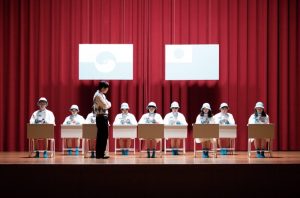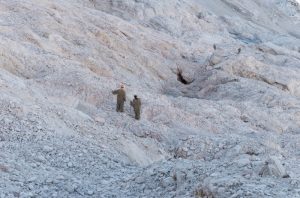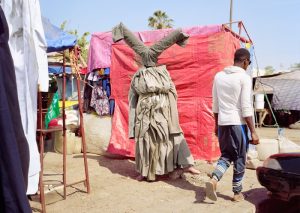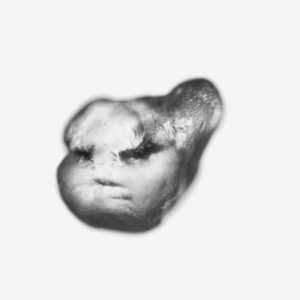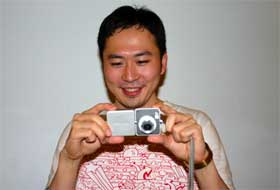 I met Takashi Matsumoto in a charming village somewhere in the Swiss Alps for the Collaborative Artefacts Interactive Furniture workshop. He was presenting a very exciting object called Z-agon, a small cube which is in fact a video player. Each face of the cube is an high-res display for multi-media contents (video). I then started to follow from afar the activities of the Keio University and discovered so many nice projects that i asked him if he’d have time to answer a few questions. Somehow, between a laptop battle, his research and maybe a couple of turntable sampling he managed to find a couple of hours to unveil what he and the other designers in his laboratories are working on.
I met Takashi Matsumoto in a charming village somewhere in the Swiss Alps for the Collaborative Artefacts Interactive Furniture workshop. He was presenting a very exciting object called Z-agon, a small cube which is in fact a video player. Each face of the cube is an high-res display for multi-media contents (video). I then started to follow from afar the activities of the Keio University and discovered so many nice projects that i asked him if he’d have time to answer a few questions. Somehow, between a laptop battle, his research and maybe a couple of turntable sampling he managed to find a couple of hours to unveil what he and the other designers in his laboratories are working on.
Can you tell us a few words about you? How did you get to work at Okude Lab? What is your role there?
First of all, I am really happy to get an interview for WMMNA! I am checking the feed everyday.
I am now a Ph.D. student of Keio University, Media Design Program and I belong to Okude Lab. In Shonan-Fujisawa Campus (SFC). I am designing user interfaces for network-based mobile gadgets. Those designs aim to provide simple embodied interactions for everyday objects to access web resources and to make our everyday lives more entertaining. My research interest is to produce an integrated design between hardwares, systems and business models for such devices.
My works like Z-agon and Pileus are futuristic but trying to be fit into a market right now. In my teenage years, I was living in Shibuya, a big commercial district in Tokyo. I have been watching how industries drop marketing to us, and I was aware of that there was a big chasm between product planning, marketing processes, and real user needs. So I studied marketing and intellectual properties in my undergraduate days. Then I realized we need a “design” of entire social and market systems to solve that problem. For example, Sony’s Walkman and MTV were medias changed a market balance and our life styles in ’80s music industry. I wanted to make such medias to change our life.
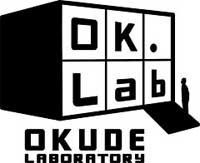 Then, I moved to Okude Lab just before I went on to master’s course. Okude Lab. is an interesting laboratory researching a media design with such a wider vision. It has been developing actual works but also concerning humans and social factors. It’s recent research focuses are designs of embodied interactions and social systems of communication media products. Okude lab. have a design method of ethnography and prototyping skills of assorted technologies to make concepts of works. Now It’s quite a big laboratory having 50 students (incl. undergraduates and graduates). Each work is designed in a collaborative team of 3 to 5 people. My works are also developed in a team.
Then, I moved to Okude Lab just before I went on to master’s course. Okude Lab. is an interesting laboratory researching a media design with such a wider vision. It has been developing actual works but also concerning humans and social factors. It’s recent research focuses are designs of embodied interactions and social systems of communication media products. Okude lab. have a design method of ethnography and prototyping skills of assorted technologies to make concepts of works. Now It’s quite a big laboratory having 50 students (incl. undergraduates and graduates). Each work is designed in a collaborative team of 3 to 5 people. My works are also developed in a team.
Okude Lab is a member of Media Design Program of Keio University (a.k.a. KMD). KMD now has 10 laboratories and we are collaborating in a big research project named “Ubiquitous Content”. I am also working as a research assistant for the Ubiquitous Content project.
What is Ubiquitous Content about? What does this expression mean? Which area does it cover exactly?
“Ubiquitous Content” is a project designated by a governmental grant of JST-CREST (Japan Science and Technology Corporation: Core Research for Evolutional Science and Technology). This is one of the biggest projects of KMD.
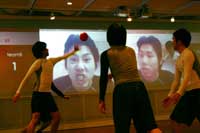 “Ubiquitous Content” is an idea of a new design objective of our lives in the post-PC era. In 20th century, a notion of media contents has been meant contents like movies, music, animations, video games etc. Figuratively speaking, such contents were entities supplied in containers designed as “boxes”. But now, a spread of networks and a
“Ubiquitous Content” is an idea of a new design objective of our lives in the post-PC era. In 20th century, a notion of media contents has been meant contents like movies, music, animations, video games etc. Figuratively speaking, such contents were entities supplied in containers designed as “boxes”. But now, a spread of networks and a
realization of ubiquitous computing technologies are going to change those styles of media. The container is not like a “box” any more: It will change its forms freely to give us advanced computer augmentations in a specific context and it will be sometimes invisible embedded into our environments. It is more appropriately called Ubiquitous Media and it will be a new style of media. When we design such Ubiquitous Media, we need to think about the container as our environments in which many things are cooperating rather than a single hardware, a single software or a single standard. Users will not need to be conscious of those medias, therefore such containers emerge for users as “their lives” themselves. “Ubiquitous Contents” are contents for such media. Those must be “experiences” in “their lives”.
As Ubiquitous Content project focuses on our lives and experiences, all things in our everyday lives are targets of the design. The 10 Laboratories of KMD are working on this wide subject from different perspectives.
For example, recent works of Ubiquitous Contents include the following topics: Yoshiro Sugano‘s ShootBall (Okude Lab) implemented a new sport using a ball with a built-in sensor and goals of visual projections. Midori Shibutani’s Fabcell (Wakita Lab) is developing a new fabric changing colors for cyber fashions. Projects like a LivePic (M. Katsura for imgl; video) and BiblioRoll (Okude Lab) are introducing a new interaction techniques for both environmental and mobile media. It also includes research topics like Cyber Sound Project (Iwatake Lab) and New Ambience (Hiroya Tanaka Lab). Topics of Ubiquitous Contents are very wide.
Each design and research works from 10 laboratories are working separately under the concept of Ubiquitous Content. And we are collaborating together to make its design theory and a platform for the basis of Ubiquitous Content. Several a year, we hold demonstration events of Ubiquitous Content works together.
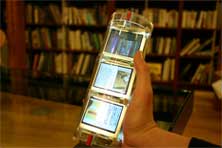
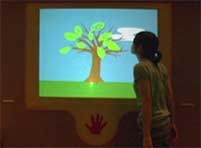 BiblioRoll and LivePic
BiblioRoll and LivePic
Most of the projects you and your colleagues have worked on are very original. There’s a magical and fairy aspect to most of them. Where do you find the inspiration? Many brainstormings? Observation of and discussions with technology users? Reading science-fiction?
The design approach of Okude Lab is based on phenomenology, which requires designers to expand their experiences and to find meanings in interactions. In particular, we go to a ethnographic fieldwork of participant observations. We participate in one activity as an apprentice finding a master of the activity in a field to find a design concept from our experiences. Then we describes a scenario to be a vision, and we iterate prototypings and its improvements. We do not do problem finding on existing designs with examinee like interviews and objective observations. The important thing is that we “designers ourselves” need to be changed in an experience in a field.
We do not start a design from a technology either. To achieve our vision for us, we will learn necessary new technologies to implement a demo. Yet we are not engineers having high-tech, we have a skill to bridge very wide technologies and know-hows between hardware, software, network technologies, form modeling, branding etc. In most of our cases, one work is implemented with numbers of programming languages, numbers of chips and hacked device modules, numbers of materials, and numbers of expression styles such as demo, video, and online.
A lodge of Okude Lab is filled with fun, free and energetic atmosphere and we are collaborating in a joyful way everyday. We don’t have hierarchies and divisions of roles in a team, and all members required to be produces with responsibilities. Some members start to live in the lodge when they get into the swing of it, and we often have a meal together, plan a short trek, and sometimes get up to mischief (did you see MacSaber video of us?). We also knows what’s up to members out of the lab sharing Flickr photos and blog RSS, and we creates edgy local and global buzz words in a lab. Such a relationship between members are making creative circumstance.
Do the researchers at Keio University Media Design get green light on whatever project they propose? What are the basic rules to respect? Do you have to come up with a marketable product for example?
In many cases, our research target is a development of a core concept of new media, but actually we eye the possibility of makertable products. However, many of our works are concepts for future and those will have some challenges to be marketable products now. So, each team manages project’s intellectual properties (such as patents) based on their long-term strategies.
We do not always have to think up a maketable product. We also have fundamental research projects, for example a design of an ubiquitous computing platform and a development of a Bayesian network engine.
Keio University is encouraging ventures from university research. Now start-ups of small innovative team is getting easier in Japan by the New Corporation Act and a diffusion of broadband internet. We are going to bring some businesses from our design research in near future. If someone interested in global business partnership and investments, please get in touch with us. We wanna make money not art.
Our aim is to give a social solution with our design proposing a new lifestyle. And recent design challenge is to learn how to design a social system. We think businesses from Keio Media Design should be a way to make a contribution to society. This is a school philosophy of Keio since inception.
Your graduate thesis was the amazing Cubic Display Device “Z-agon”. What have you learnt from this project? What were the biggest challenges of the design and construction of Z-agon?
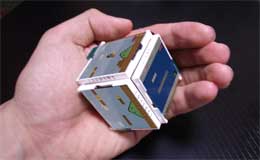 Z-agon was the first work at Okude Lab for me. The project was started during the summer of 2002. Our team was thinking about a portable media of next generation, and we decided to design a new video player as we all agreed that our needs are shifting toward video (multi-media) contents like music clips and animations. The first inspiration was a 6-channels-TV-Cube, and it did not take time to find a target of the “Wi-Fi based video cube for social-sharing contents”.
Z-agon was the first work at Okude Lab for me. The project was started during the summer of 2002. Our team was thinking about a portable media of next generation, and we decided to design a new video player as we all agreed that our needs are shifting toward video (multi-media) contents like music clips and animations. The first inspiration was a 6-channels-TV-Cube, and it did not take time to find a target of the “Wi-Fi based video cube for social-sharing contents”.
The concept is that 6 displays of a small cube get vide displays, and it is operated by physical turns of the device.
Most parts of Z-agon‘s design are envisions. Its goal is to provide high-res color images of movies, music, animations and games, and the 2.5 inch size was also necessary for its interaction and its element as an accessory. However it was almost impossible to realize Z-agon at the time when the 1st-gen music ipod just appeared to the market with a black and white display. When we introduced our concept to public, there are many company engineers who are really critical for it.
However, as we have had experiences feeling needs for this concept and we believed from surveys that technologies evolves to this direction in few years, we thought we should not throw off this concept. The first prototype was in a 12 inch cube that was quite big apart from the concept. And we filled in the gap making a conceptual movie with a futuristic scenario, and studying interaction research on a 2.5 inch cube. We got a patent for the basic device of the interactive cubic display. Then its design has been progressed. Z-agon has a dream that one day it has a quality of a commercial product. In that regard, our handmade prototypes are still functionally incompletion with technological difficulty. But now 5 years after the project started, it is obvious that the concept is getting more realistic, here, we already got similar devices like iPod Nano and Nintendo DS.
We already excepted that users want to share video contents on the Internet. (See the concept movie in 2002) It was because we found that needs from experiences and observations as new generation in Tokyo. Now, you see a big boom of YouTube. We hope Z-agon will be a wi-fi video player for such content sharing services. We feel this kind of predictions and envision on design were really important to drive the project.
What inspired Pileus: The Internet Umbrella (video)? What did you want to achieve with this project from the KMD Okude Lab? How will it evolve in the near future?
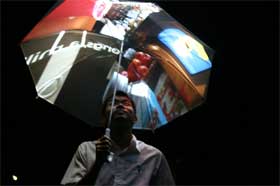 Pileus is the most exciting project for me right now. This work is designed in a team with Sho Hashimoto, who has a unique engineering skill in the lab. We started this project in a kick-off camp of a spring semester in 2006. the initial concept and the first scenario movie were completed in just 3 days of the camp.
Pileus is the most exciting project for me right now. This work is designed in a team with Sho Hashimoto, who has a unique engineering skill in the lab. We started this project in a kick-off camp of a spring semester in 2006. the initial concept and the first scenario movie were completed in just 3 days of the camp.
We have many rain in Japan. So the umbrella is one of the closest article of everyday use, but it is also a bulky article in such a climate. Traditionally we have been feeling many kinds of air and mood in a rainy day, and we wanted to expand that feeling to be more fun and vivid with the re-design of an umbrella. From that perspective, we came up with the idea of umbrella to take photo-logs and to browse internet contents in a rain. Me and Sho already took notice of that we can provide many kinds of services in a real world with Web2.0, and also had a technological vista to mash-up those with a mobile hardware. Additionally, it was another target that this can be the first example of a hardware mash-up to indicate a new economic solution for mobile gadgets joining into an economy of Web 2.0. We do not want a small “Cellphones” (Smartphones, whatever) squashing up many functions inside, but we re-designed an object of everyday use from scratch to be mashed-up with web services.
At the end of last year, we founded a spined-off LLC for the project, and we are thinking how it will go a business exit.
As the ideology of the design of Pileus, we would like to show that design is not about its shape any more; an apt assortment of modules and interactions are more important factors for the design. So, our prototype is showing off the circuits to see how modules are combined rather than covering it. Some people suggest us to give a beautiful surfaces for it as a “design”, but that is not what we want to do now, we are meticulous about the interaction of information visualizations on the screen though. Fortunately, this rugged look is loved by many audiences at demo sites.
As an exclusive info, we have builded a new version of Pileus with GPS. A new function with GPS is geo-tagging of photos taken by Pileus. It will help to users to check and share records of their walks in the rain. Another function is a map display of an area. This will be used for a big-screen navigation in an umbrella, and it will be able to show local pictures and local ads are loaded on the umbrella. Of course, this function is also realized by a mash-up technique. Now we are using Yahoo! Maps API, but we may switch it to Google Maps API because Japanese map on Yahoo! maps has bad scale ratio. We are going to go an experiment in a city in a rain, however, unfortunately we have had few rainy days this year yet.
Can you tell us a few words about Post-Bit: Multimedia E-paper Stickies? (video 1 and 2)
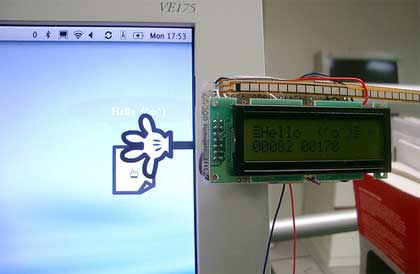
I have participated in an internship at FX Palo Alto Laboratory Inc. (FXPAL) in Silicon Valley in 2004. Post-bit was an e-paper device designed at the intern. As you will see, it is a small e-paper memo and It is named after 3M’s “post-it”.
When I studied a working space, I found paper post-its are still heavily used in a office although PC and digital gadgets are diffused. As FXPAL and the Xerox group has a technology of e-paper, I thought about a design of tiny memos of e-paper. I imagined making paper prototypes that encrusting multimedia contents on tiny papers in a physical workplace must be be useful and kawaii.
The design theme was to integrate the advantage of tangibility of papers and the advantage of dynamic usages of digital data. There, I invented “drop-beyond-drag” which is a exchange system between GUI and TUI. It enables users to directly drag-and-drop a file from GUI desktop to an e-paper putting on the display flame, and reversely user can just squeeze the memo to splash a content onto the GUI desktop from a memo on the flame. I made a prototype and a concept video with helps of Maribeth Back and Tony Dunnigan, and the video was introduced on a video track of ACM multimedia 2005.
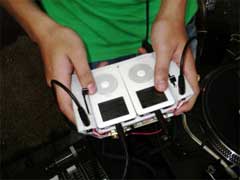 Are you an ipodj?
Are you an ipodj?
Haha, Yes, that was a funny trial with my high school friends. This idea is still popular. As we got busy for our primary jobs, the project has been stopping after the creation of tiny DJ mixer for ipods, though.
I do DJ sometimes at my friend’s home parties and parties in the lab with analog turntables. I like scratching on it. By the way, to do mash-up on a design is really similar feeling to do sampling on turntables, you know…
Thanks Takashi!
More images.

